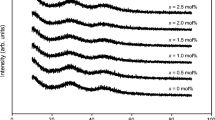Abstract
Oxide glasses with the general formula (Bi2O3)1 - x(CuO)x have been prepared by quick quenching technique. Their longitudinal and shear elastic moduli have been determined by measuring the corresponding ultrasonic wave velocities between 300 and 470 K, which are well below the glass transition temperature of this system. Temperature variation of ultrasonic velocity and attenuation exhibit anomalies around 435 K in glasses with x ≥ 0.3. A nonlinear behaviour is also reflected in the CuO concentration dependent dielectric constant curve around x = 0.3. These anomalies are interpreted in terms of a structural softening (or transformation) taking place in samples having CuO concentration above the critical value. The high dielectric constant of these glasses show very little increase with increase of temperature. Anomalies are also found in the temperature dependence of dielectric constant around 435 K. This behaviour is again considered to be associated with the softening of the glass network.
Similar content being viewed by others
References
H. Hirashima, Y. Watanabe and T. Yoshida, J. Non-Cryst. Solids 95 & 96 (1987).
Y. Sakuri and J. Yamaki, J. Electrochem. Soc. 132 (1985) 512.
S. Nakamura and N. Ichinose, J. Non-Cryst. Solids 95 & 96 (1987) 512.
M. E. Lines, J. Appl. Phys. 69 (1991) 6876.
T. Komatsu, R. Sato and K. Matusuita, Appl. Phys. Lett. 54 (1990) 170.
K. B. R. Varma and K. J. Rao, ibid. 54 (1989) 69.
R. C. Baker, W. M. Hurng and H. Steinfink, ibid. 54 (1989) 371.
S. R. Elliot, “Physics of Amorphous Materials,” 2nd ed. (Longman Scientific and Technical, 1990).
W. H. Zachariasen, J. Amer. Chem. Soc. 54 (1932) 3841.
W. A. Phillips (ed), “Amorphous Solids,”(Topics in Current Physics) Vol.24, (Springer-Verlag, 1981).
J. Jachle, L. P. Iiche, W. Arnold and S. Hunklinger, J. Non-Cryst. Solids 20 (1975) 365.
R. C. Buchanan, “Ceramic materials for electronics,” (University of Illinois Press, 1991).
D. K. Burghate, S. G. Moke, W. J. Gawande, S. V. Pakade and S. P. Yawale, Ind. J. Phys. 68A (1994) 141.
N. F. Mott and E. A. Davis “Electronic processes in non. crystalline materials,” 2nd ed. (Oxford University Press, 1971).
E. P. Papadakis in “Physical Acoustics,” Vol. 12, edited by W. P. Mason and R. N. Thurston (Academic Press, NewYork, 1976).
H. J. Mc Skimin, J. Acoust. Soc. Amer. 33 (1961) 12.
E. Schreiber, O. L. Anderson and N. Soga, “Elastic constants and their measurements,” (Mc Graw Hill, New York, 1973).
I. G. Austin and N. F. Mott, Advances in Physics 18 (1969) 41.
N. F. Mott, J. Non-Cryst. Solids 1 (1968) 1.
Author information
Authors and Affiliations
Rights and permissions
About this article
Cite this article
Philip, J., Rodrigues, N., Sadhukhan, M. et al. Temperature dependence of elastic and dielectric properties of (Bi2O3)1 − x(CuO)x oxide glasses. Journal of Materials Science 35, 229–233 (2000). https://doi.org/10.1023/A:1004785809370
Issue Date:
DOI: https://doi.org/10.1023/A:1004785809370




